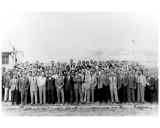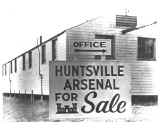1948 & 1949
|
1948 Bryant-Harper & Company, Inc. leased three Huntsville Arsenal buildings to recover white phosphorus from white phosphorus-filled munitions. 19 January 1948 The Huntsville Arsenal Security and Intelligence Division received a call from Arab, Alabama, located about 35 miles south of Huntsville, for assistance in fighting a fire at a hardware and furniture store. |
|
30 April 1948 The War Assets Administration (WAA) advised the Army Chief of Engineers that the agency could not assume jurisdiction of Huntsville Arsenal because the installation had vast amounts of equipment and supplies to be removed to other locations. The presence of large areas of contaminated property also precluded the WAA from assuming jurisdiction. Consequently, the WAA maintained that the arsenal was not surplus property within the meaning of the term as used in the Surplus Property Act of 3 October 1944. Because the CWS could not comply with the WAA's requirements before 1 March 1949, the jurisdiction and administration of Huntsville Arsenal remained a DA responsibility. June 1948 Huntsville Arsenal land rented as of this date totaled 12,651.82 acres. Of this, 4000 acres were in grain, 2700 were in hay, 4400 were in grazing, and the rest was non-productive. 9 June 1948 Miss Eleanor G. Shaw, an industrial specialist in the Engineering and Facility Planning Branch of Huntsville Arsenal's Procurement and Procurement Planning Division, was named arsenal historian. 30 June 1948 The vast bulk of deactivation work at Huntsville Arsenal not related to demilitarization, decontamination, or destruction was completed. 22 July 1948 Operations began on the first line constructed for the demilitarization of the M-17 incendiary cluster, the largest of the demilitarization projects at Huntsville Arsenal. Because the production rate was below that required for completion of the program by 31 March 1949, a second line was installed. The estimated average production of one line was 175 clusters per 8-hour shift. About half of the 81,055 clusters were demilitarized during the last half of 1948. 1 September 1948 The Gulf Chemical Depot Activity was discontinued, after completing the shipment of Class A munitions and standby equipment to other installations. A new Demilitarization, Decontamination, and Destruction Activity was created on the same date. It was responsible for performing all necessary demilitarization and destruction of chemical and toxic agents, equipment, and materiel. The demilitarization of the M-17 bomb clusters was included in the new division's mission. October 1948 Following an extensive survey of all available Ordnance installations, the Chief of Ordnance designated Redstone Arsenal as the center for Ordnance rocket research and development. 1 October 1948 Huntsville Arsenal was put under the command and control of the Commanding General, Third Army for participation in the Territorial Command Test (Operation TACT) for 6 months. November 1948 Negotiations on a 10-year lease for buildings 639 and 640 began at Huntsville Arsenal. Planters Warehouse and Storage of Huntsville, Alabama, was granted right of entry the following month for the purpose of storing baled cotton. 9 November 1948 The Chief of the Chemical Corps removed Huntsville Arsenal from the surplus category and placed it on standby status for possible use by the Department of the Air Force. Plans were also made to go on an austerity standby basis in Plant Areas 2 and 3 by 1 July 1949. 22 November 1948 Huntsville Arsenal was authorized to hire a Post Chaplain. A special allotment was provided to cover services through 31 December 1948. 30 November 1948 COL Carroll D. Hudson was reassigned to Redstone Arsenal to guide it through its reactivation period. He remained well into the missile era (7 May 1952). 31 December 1948 By this date, 419 of the 1083 buildings and structures on Huntsville Arsenal had been placed in standby status, leaving 558 still to be placed in standby. Another 58 structures were outleased, while 1950 were used by utilities. 1949 Redstone Arsenal received responsibility for technical supervision of the T133 High Explosive Rocket. However, the rocket never reached the production stage. Ordnance terminated the project in March 54 because the Army Field Forces had no requirement for it. 5 January 1949 Huntsville Arsenal's Security and Intelligence Division received a general call from the Huntsville mayor and chief of police requesting aid in evacuating people from flooded low-lying areas of the city. Third Army Headquarters approved the use of 10 trucks and 25 men to assist in the effort. February 1949 The Research and Development Division, forerunner of the Ordnance Rocket Center, was established at Redstone Arsenal. 15 March 1949 A 5-year lease for buildings 1052, 1053, 1054, and 1058 was signed with Charles H. Cummings. The structures were used for cotton storage and sampling. 16 March 1949 The John Powell Company was granted right of entry to the north section of building 781 for chemical manufacturing. |
|
Huntsville Arsenal remained under the command of the Third Army until 30 June 1949, when it became part of the neighboring Ordnance installation. Third Army funding was finally removed on 31 October 1949 when the Territorial Command Test ended. Corps of Engineers' sign advertising Huntsville Arsenal for Sale 31 March 1949 The Huntsville Arsenal Station Hospital was discontinued and an Industrial Dispensary was established in its place. 31 March 1949 Civilian firemen-guards replaced the military personnel assigned to Huntsville Arsenal as guards and fire fighters. The Alabama State Patrol and the Madison County Sheriff's Office agreed to allow military personnel under confinement to be detained in the county prison because no military guards were available after this date. April 1949 The Elkton Division of the Thiokol Corporation, located at Elkton, Maryland, signed an Army contract to research and develop rocket propellants. This activity moved to Redstone Arsenal, where it began operation in June 1949. |
|
April 1949 The Rohm and Haas Company signed an Army contract to do research and development work on rockets and jet propulsion at Redstone Arsenal. |
 |
|
May 1949 The Ordnance Corps initiated a project to develop an improved 3.5-inch high explosive antitank rocket. Redstone Arsenal's task was to design and develop the rocket motor. Rohm and Haas, the rocket motor contractor, completed motor development at the installation in June 1955. May to June 1949 The Industrial Research Corporation, Detroit, Michigan, made a comprehensive industrial survey of Huntsville Arsenal's buildings and grounds. The Army Corps of Engineers had contracted for this survey for use in advertising the installation's sale. June 1949 One of Redstone Arsenal's first assignments was to serve as technical supervisor of the T137 Area Saturation Weapon project. Arthur D. Little, Inc. became project contractor in August 1951. The contract was terminated in February 54 and all other activity on the project ceased by 1 July 1954. 30 June 1949 Huntsville Arsenal ceased to exist as a separate installation at 2400 hours. Its remaining staff of 450 was transferred to Redstone Arsenal, which also assumed the functions necessary for providing internal security and maintaining essential utilities for lessees pending final disposition of Huntsville Arsenal's land and property. There were no organizational changes in the Redstone Arsenal command except for the addition of the Huntsville Arsenal area, which was officially designated the Chemical Division. 28 October 1949 The Secretary of the Army approved the transfer of the Ordnance Research and Development Division Sub-Office (Rocket) at Fort Bliss, Texas, to Redstone Arsenal. Among those transferred were Dr. Wernher von Braun and his team of German scientists and technicians, who had come to the United States under "Operation Paperclip" during 1945 and 1946. |
The Pre-Missile Era: Introduction, 1941 , 1942 , 1943 , 1944 , 1945 , 1946 & 1947 , 1948 & 1949



